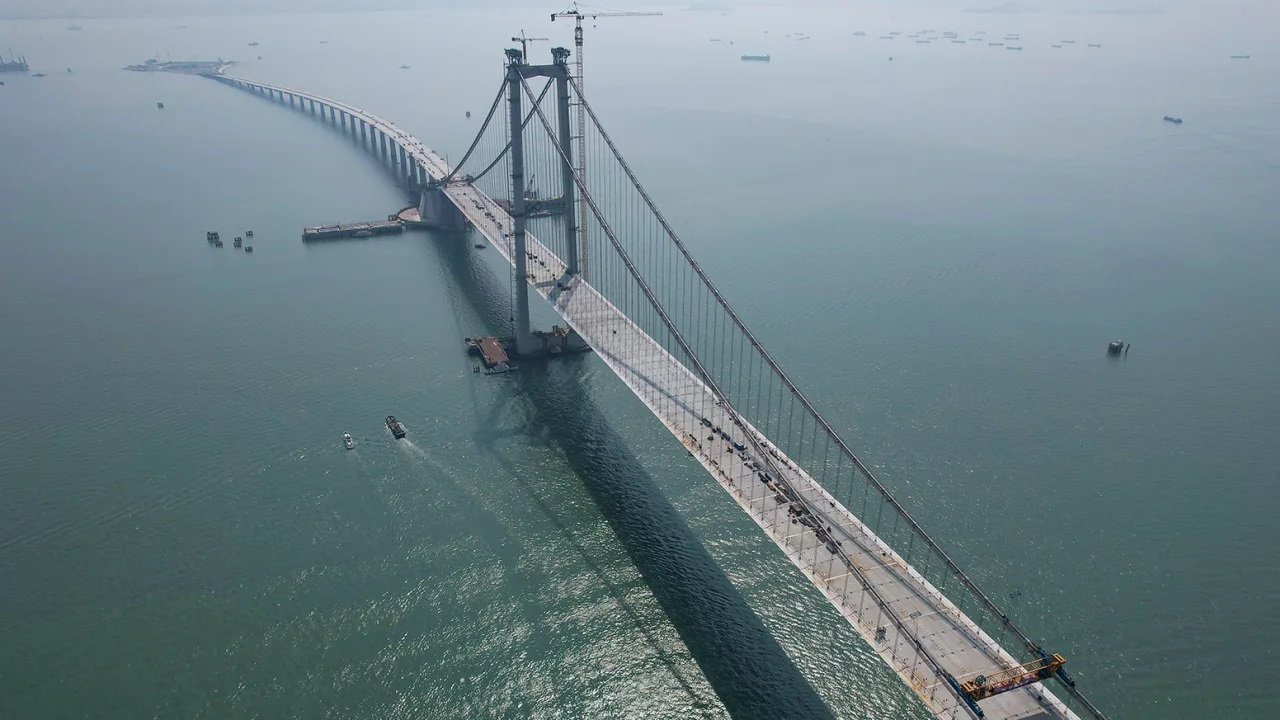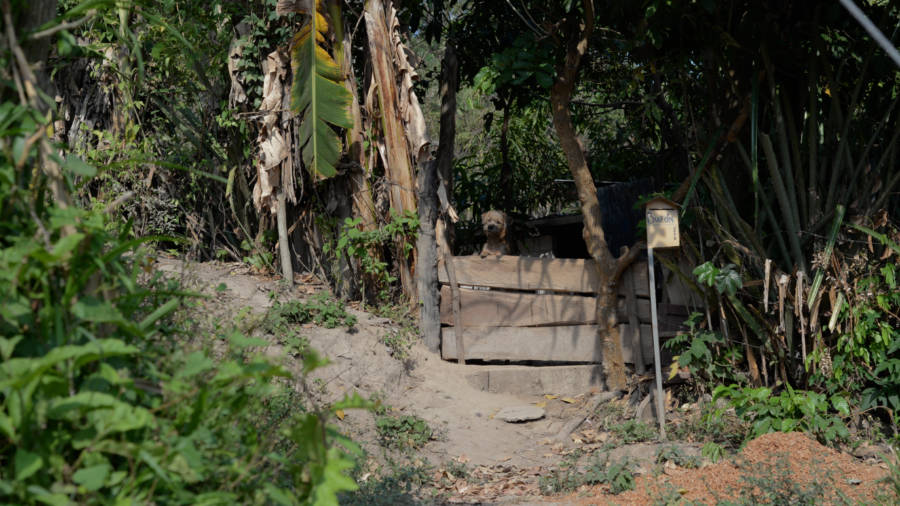Hong Kong (CNN) — Even in a country known for its massive, landmark infrastructure, the project is backfiring. At 24 kilometers long, eight lanes wide, with artificial islands and an underwater tunnel, China’s $6.7 billion Shenzhen-Zhongshan Bridge is ambitious.
To much fanfare in the country’s state media, bridge builders recently set a new world record by laying 22,600 square meters of asphalt in a single day, the equivalent of more than 50 basketball courts.
Strange as it may seem, it is not the longest sea bridge in the world. That honor is only 32 kilometers behind its 54-kilometer-long neighbor, the Hong Kong-Zhuhai-Macau Bridge.
For some observers, building these grand bridges together is a testament to both China’s growing ambitions on the world stage and the difficulties it faces in making them a reality.
Like its sibling in Hong Kong, when the Shenzhen-Zhongshan Bridge opens to traffic next year after eight years of construction, it will be one of the pillars to transform China’s largest and most populous Greater Bay Area. In the world, an economic and technological center rivaling San Francisco, New York or Tokyo.
As big as bridges is an ambition. The Greater Bay Area has a population of 68 million, occupies 35,000 square kilometers and includes 11 cities: Hong Kong, Macau and Zhongshan, and nine cities including Shenzhen. Shenzhen alone has more than 12 million people, not to mention dozens of multibillion-dollar companies like drone maker DJI and social media giant Tencent, which have helped earn it the nickname “Chinese Silicon Valley.”
Beijing hopes these bridges will help unite cities in this large and diverse region, both physically and ideologically. Travel times between Zhongshan and Shenzhen Bao’an International Airport – China’s third busiest, handling more than 37 million passengers in 2019 – are expected to drop from two hours (using existing highways) to 20 minutes.
But many observers believe the bridges serve another, more political purpose, aimed at uniting the now very different regions—Hong Kong a former British colony, Macau a former Portuguese colony—under a single Chinese identity. And, according to some critics, the size of the company even dwarfs the size of the bridges.
A declaration
Austin Strange, a China foreign policy expert at the University of Hong Kong, says the new bridge will undoubtedly bring “real economic value” by drastically reducing travel times between cities and traffic.
But he said there is also a secondary dimension, compared to China’s Belt and Road Initiative, in which Beijing is funding billions in infrastructure projects such as ports and highways in countries around the world.
The plan is seen as an attempt by China to increase its economic and political influence on the world stage, and some critics accuse it of putting pressure on smaller countries by giving them loans they can’t repay.
While bridges being built on Chinese soil do not raise debt issues, observers say the scale of the project sends a message.
“The Chinese government is clearly touting this bridge as a world-class achievement,” says Strange. “Infrastructure is an essential part of China’s reputation in global development and is a key link in how China approaches domestic and international development.”
The Shenzhen-Zhongshan Bridge Project includes artificial islands and an underwater tunnel.
However, the deep impression the bridge makes on the rest of the world depends not only on its size, but also on its success and popularity among travelers.
Otherwise, you’re often criticized for some of the Belt and Road’s grandiose plans: you’re dealing with an expensive white elephant.
Like the bridges connecting the shores of San Francisco Bay, the Chinese mega-project will greatly reduce travel times, said He Zhiguo, a finance professor at the University of Chicago.
However, only the citizens of Zhongshan will benefit, as it is a sleepy town that is neither a business center nor a tourist area, giving little incentive for others to visit.
Estimates of the impact on travel times and costs should be taken with a grain of salt, he added, as plans could easily be scaled up. “That’s my concern. But without knowing more, I think it’s not a bad idea,” he said.
Bridges over troubled waters
As ambitious as Beijing’s vision for the Greater Bay Area is, many bumps in the road have already arisen.
The idea was first mooted in 2009, but development has been hampered by differences and barriers between some of the cities involved, experts say.
The region has three borders: mainland China and the former colonies of Hong Kong and Macao, which are now semi-autonomous special administrative regions of China, each maintaining separate immigration systems, legal systems and currencies.
In addition, residents carry three different passports and identity cards, and speak two different forms of Chinese (Cantonese and Mandarin).
They drive on different sides of the road, presenting endless obstacles to those who wish to have a carefree road trip with each other.
Critics say some of these problems came to the fore when the Shenzhen-Zhongshan Bridge’s sister project, the $20 billion Hong Kong-Zhuhai-Macao Bridge, opened in 2018.
The bridge connects the Chinese mainland city of Zhuhai with the gaming hub of Macau and the major financial center of Hong Kong.
According to the Hong Kong Department of Transport, in 2019, a year after its launch, it is still struggling to attract traffic, recording 4,000 trips per day. (By comparison, the Channel Tunnel in Europe, which connects France and Britain, attracted an average of 8,000 vehicles a day in March this year, according to its website.)
Travelers are responding differently to the need to obtain different visas and vehicle registrations to travel between the three destinations, especially since high-speed ferries already cross the three cities on a daily basis and frequently depart from central terminals. rather than border areas where bridges begin.
Traffic on the Hong Kong bridge was reduced to hundreds of vehicles a day during the Covid pandemic as the three regions sealed their borders as part of a strict “Covid Zero” policy, although its use has increased. During the Labor Day holiday this month, state media reported that up to 9,000 vehicles were passing through each day.
Meanwhile, the controversy over the bridges goes beyond purely financial issues.
Some see the bridges as a political act. Protesters criticize Hong Kong’s bridge, which was rocked by pro-democracy protests in 2014 and 2019, as a means of consolidating and exerting control over the city.
An aerial view of the Hong Kong-Zhuhai-Macao Bridge, the world’s longest sea bridge, is seen in Zhuhai city, south China’s Guangdong province, on March 19, 2019.
“Don’t worry, there will be traffic jams”
Even so, bridges have their fans.
Xiao Geng, director of the Policy and Training Institute at the Shenzhen Campus of the Chinese University of Hong Kong, says the Shenzhen-Zhongshan Bridge will help balance the two regions.
“The west side of the coast is not as developed as the east, and there is a big difference in property prices between the two,” Xiao said.
The bridge differs from its predecessor in that it is surrounded by “fundamentally different” settings of the three destinations, which put people off by raising the cost of travel.
The latest bridge will connect two major Chinese cities that were already under the same regulations, he said.
“Don’t worry, there will be a traffic jam,” he said.
Additional reporting by CNN’s Sarah Lazarus.





